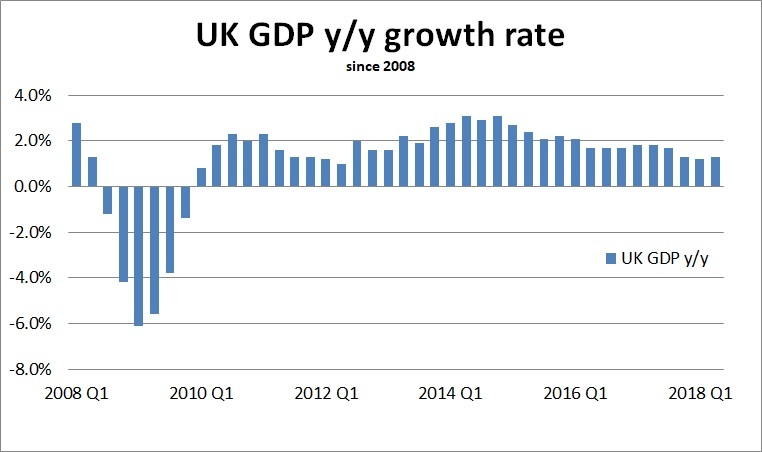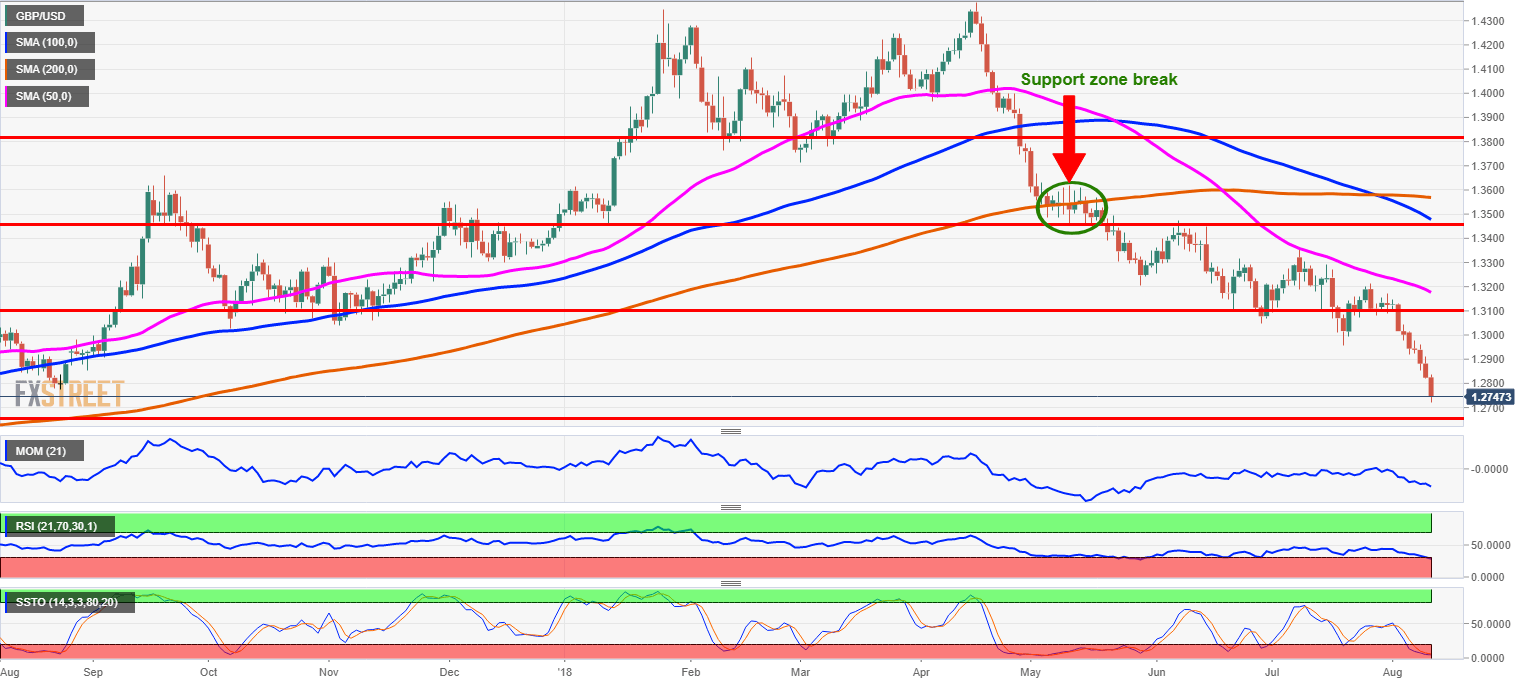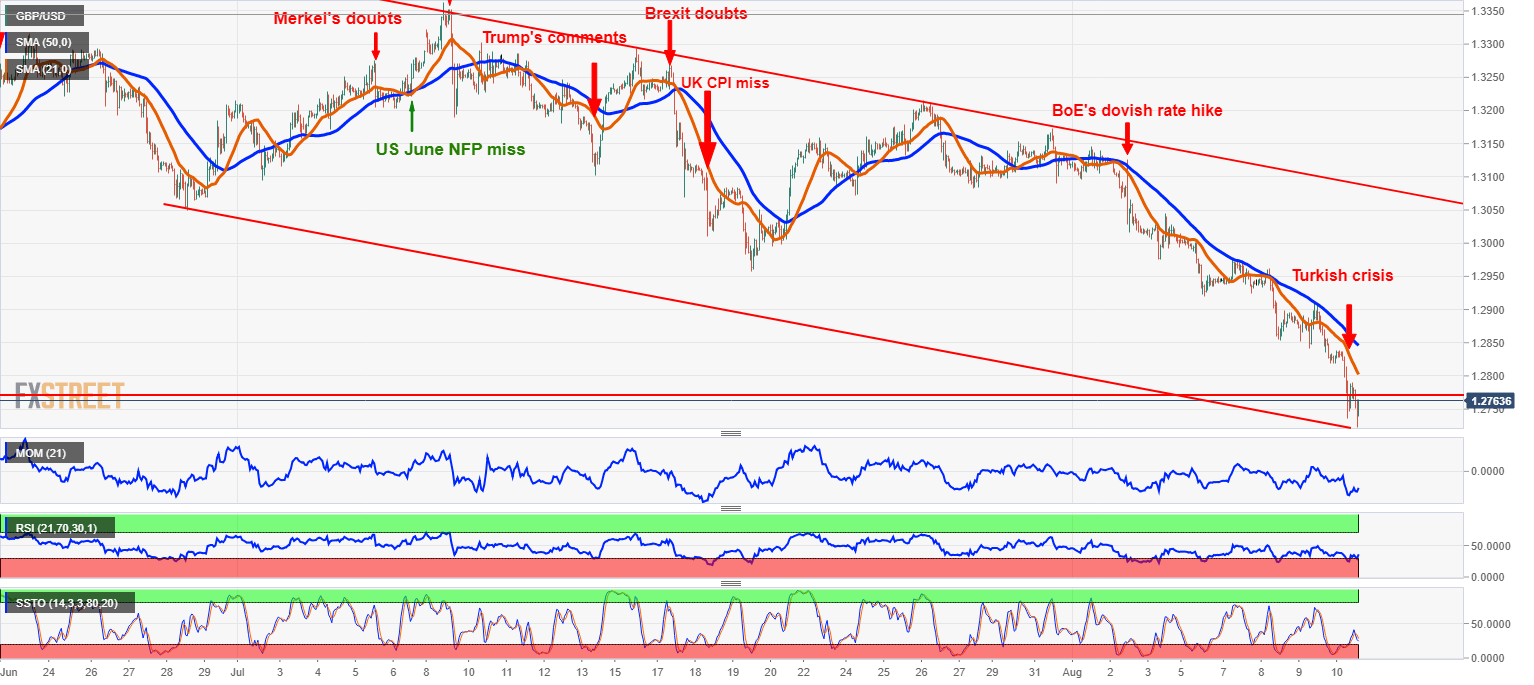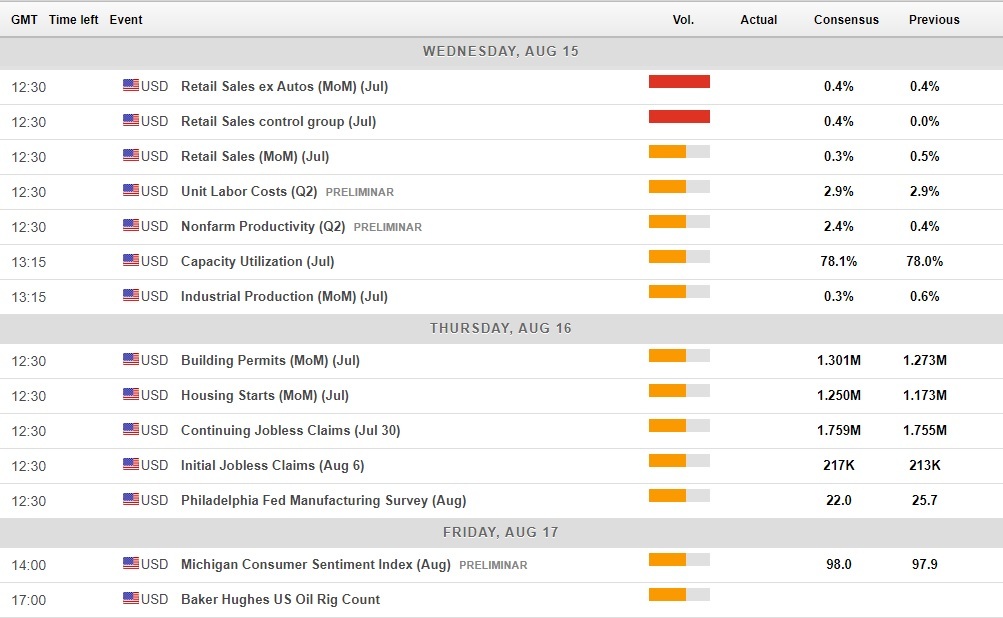- The GBP/USD was hammered to the lowest level since June 27 last year as no-deal Brexit and Turkey related turmoil weighed.
- The trinity of important UK macro releases in the week ahead is unlikely to change the overall picture as the risk aversion favors the US Dollar.
- The Bank of England dovish rate hike on Thursday made no cushion for Sterling as Carney emphasized gradual and limited scope for future moves higher.
- The FXStreet Forecast Poll turned overly bearish with a no-deal Brexit uncertainty turning to nightmare for market discounting increased probability of such scenario.
Sterling is set to end the second week of August down 1.7% over the week opening at the psychologically important level of 1.3000 and ending at the lowest level since August last year. In absence of the fundamental data, it was a no-deal Brexit fear that dominated the news over the course of the second week of August. On Friday, Turkey-related market turmoil and subsequent flight to safety saw Sterling falling as low as 1.2723.
The second week of August was almost data empty, but the Brexit deal news fully occupied the news space pressing the currency pair lower day-by-.day
The news of no-deal Brexit weighed on Sterling sending it to the lowest level since August 31 last year and coupled with earlier comments from the outgoing Monetary Policy Committee (MPC) member Ian McCafferty who added to the no-deal Brexit fear in a public debate together with dovish monetary policy outlook.
McCafferty repeated that no-deal Brexit would cause short-term economic disruption and more importantly he confirmed that the market expectations for a couple of rate hikes during the next two years are acceptable. The August Inflation Report projections were conditioned on the Bank rate rising from 0.5% before this month's meeting to 1.0% by Q1 2020 and then edging higher to 1.1% by Q3 2021.
Although Ian McCafferty is an external Monetary Policy Committee member who is leaving the MPC at the end of this August, his hawkish views are well known as he was voting for a rate hike since March until the Bank of England raised the Bank rate to 0.75% last week delivering dovish monetary policy outlook.
The Brexit related uncertainty has been raised repeatedly with the Bank of England Governor Mark Carney sending a warning signal to business and the financial markets on Friday, August 3rd saying it is “uncomfortably high” and the UK Trade minister Liam Fox saying last Monday that a no-deal Brexit has a 60% chance of happening.
Such news was also complemented with reports of the UK Cabinet holding a special meeting in mid-September for preparation for the no-deal Brexit scenario. With the European Union ready to provide the UK Prime Minister with some kind of Brexit concessions and Sterling continuously falling on any rumor of Brexit doubts, it looks like there is no mercy for Sterling whatever the UK government plans for Brexit and a no-deal Brexit scenario is being accepted as new reality.
As far as concerning the economic fundamental, the only important piece of news was Friday’s UK second-quarter GDP report that saw economic growth doubling to 0.4% Q/Q compared with 0.2% Q/Q in the first quarter. While the UK economic growth rate met the market expectations, the UK manufacturing output in June rose 0.4% over the month in June, coming out slightly better than expected.
UK GDP growth rate
Source: ONS, Chart: FXStreet
At the time of the UK manufacturing output and UK GDP news, the story of Turkey being the main source of a possible crisis hit the market causing Turkish lira to collapse and sending the shock wave across the market of the globe. Resulting risk-off market sentiment saw Sterling falling past 1.2800 all the way to 1.2723, the lowest level since July 27 last year.
As the week ahead is set to bring solid economic data fro the UK including strong July labor market report, with wages rising 2.6% and the unemployment rate stuck to a 4-decade low of 4.2%. The UK inflation is expected to accelerate slightly in July while retail sales are seen rising modestly in the same month.
Technically, the GBP/USD is moving within a downward sloping trend channel with technical oscillators including the Relative Strength Index and Slow Stochastics moving from the neutral zone to oversold territory. The Slow Stochastics is set to make a bearish crossover in the oversold territory after the no-deal Brexit news and the Turkish crisis related risk-off sentiment saw Sterling falling to the 14-month low. After the GBP/USD fell for seven days in a row and the roll down is basically exhausted, the technical correction is expected to come, especially with help of solid economic fundamentals. From mid 1.2700s the correction is expected to see GBPO rising to 1.2800 first before targeting 1.2850 and 1.2900. On the flip side, the bearish trend is ultimately targeting 1.2670 represented by the Fibonacci retracement of the post-Brexit slump correction from 1.1940 to 1.4377.
Technical analysis
GBP/USD daily chart
The GBP/USD opened the second week of August at 1.3000 on the daily chart with the downtrend dampening the spot rate to a low of 1.2723 on Friday at the peak of the Turkey-related crisis. The news of a no-deal Brexit from different officials in the UK government and the Bank of England saw the GBP/USD continuously falling over the course of the week with technical oscillators like Momentum and the Relative Strength Index moving lower. The Relative Strength Index and Slow Stochastics moved to the neutral territory and in combination with solid economic fundamentals due during the third week of August it should bring a technical correction for Sterling higher. On the upside levels of 1.2800 and 1.2850 look to be immediate targets with 1.2900 eventually becoming a target as well.
GBP/USD 1-hour chart
The GBP/USD looks set for a correction on a 1-hour chart as the currency pair is stuck to the lower bound of the downward sloping trend. Technical oscillators like Momentum and the Relative Strength Index moving upwards after falling to oversold territory and the Slow Stochastics moved away from the oversold territory. With the spot rate at the middle of 1.2700s before the weekend, for the future correction, the currency pair needs to sustainably close above 1.2800 to move towards 1.2900 next.
Economic fundamentals in the week ahead
The UK macro calendar for the third week of August includes Tuesday’s UK labor market report, the UK inflation data on Wednesday and Thursday’s retail sales report. The UK labor market is expected to remain strong with the unemployment rate stuck to a 4-decades low of 4.2% in July and wages excluding bonuses rising 2.6% over the year in the three months to June period. Wages including bonuses are expected to remain unchanged at 2.5% y/y in three months to June.
The Uk inflation rate is expected to accelerate to 2.5% y/y in July with core inflation remaining stagnant at 1.9% y/y after surprising deceleration in the previous month. At the same time, the Bank of England representatives are set to explain reasons for their early August rate hike in the Inflation Report parliamentary hearing.
The UK retail sales in July are set to conclude the trinity of the macroeconomic indicators due next week with core retail sales seen stagnating while total sales seen rising modestly in July, despite English football team progressing into the World Cup semi-finals with consumption of beer and BBQ up according to early estimates.
UK economic calendar for August 13-17
On the other side of the Atlantic, the third week of August is set to deliver US retail sales report on Wednesday with rather minor reports on US housing and labor market complementing the week.
The core US retail sales are seen rising 0.4% m/m in July, unchanged from the previous months and unlikely to become major market driver anyway.
With the Turkish crisis bursting out as the first victim of the trade war, Trump’s tweets and sentiment is left to dominate the market.
US economic calendar for August 13-17
Forecast for the next week
The FXStreet Forecast Poll for the week ahead turned overly bearish for Sterling estimating the exchange rate of GBP/USD at 1.2774, down from 1.2947 last week and with the GBP/USD spot rate at around 1.2770 at the time of finishing this report on Friday afternoon in Barcelona.
While bullish versus bearish predictions distributed 23% of bullish versus 54% of bearish predictions among forecasters participating at the FXStreet Forecast Poll this week, the last forecast for the second week of August expected spot rate to fall to 1.2974 with only 19% of bullish versus 69% of bearish predictions for the week ahead. The increasing Brexit uncertainty weighed heavily on Sterling during the second week of August that saw Sterling falling almost 2%. A no-deal Brexit factor together with the Bank of England delivering a very dovish rate hike two weeks ago saw the FXStreet forecasters turning increasingly bearish.
As long as longer-term forecasts are concerned, the FXStreet Forecast Poll turned back more bearish after the increased nop-deal Brexit expectations. Compared to last week when FXStreet Forecast Poll saw GBP/USD at 1.3078 in one month time from now, the median forecast for one month is now 1.2928 compared to 1.3171 two weeks ago and compared to 1.3021 three weeks ago.
The same bearish turn is seen in predictions for three months time from now, with FXStreet Forecast Poll forecasting GBP/USD at 1.3010 in three months time from now compared to 1.3064 1.3195 last week, 1.3195 forecasted two weeks ago and 1.3181 predicted three weeks ago.
Related Forecasts
Note: All information on this page is subject to change. The use of this website constitutes acceptance of our user agreement. Please read our privacy policy and legal disclaimer. Opinions expressed at FXstreet.com are those of the individual authors and do not necessarily represent the opinion of FXstreet.com or its management. Risk Disclosure: Trading foreign exchange on margin carries a high level of risk, and may not be suitable for all investors. The high degree of leverage can work against you as well as for you. Before deciding to invest in foreign exchange you should carefully consider your investment objectives, level of experience, and risk appetite. The possibility exists that you could sustain a loss of some or all of your initial investment and therefore you should not invest money that you cannot afford to lose. You should be aware of all the risks associated with foreign exchange trading, and seek advice from an independent financial advisor if you have any doubts.
Recommended Content
Editors’ Picks
EUR/USD hovers around 1.0700 after German IFO data

EUR/USD stays in a consolidation phase at around 1.0700 in the European session on Wednesday. Upbeat IFO sentiment data from Germany helps the Euro hold its ground as market focus shifts to US Durable Goods Orders data.
USD/JPY refreshes 34-year high, attacks 155.00 as intervention risks loom

USD/JPY is renewing a multi-decade high, closing in on 155.00. Traders turn cautious on heightened risks of Japan's FX intervention. Broad US Dollar rebound aids the upside in the major. US Durable Goods data are next on tap.
Gold price trades with mild negative bias, manages to hold above $2,300 ahead of US data

Gold price (XAU/USD) edges lower during the early European session on Wednesday, albeit manages to hold its neck above the $2,300 mark and over a two-week low touched the previous day.
Worldcoin looks set for comeback despite Nvidia’s 22% crash Premium

Worldcoin price is in a better position than last week's and shows signs of a potential comeback. This development occurs amid the sharp decline in the valuation of the popular GPU manufacturer Nvidia.
Three fundamentals for the week: US GDP, BoJ and the Fed's favorite inflation gauge stand out Premium

While it is hard to predict when geopolitical news erupts, the level of tension is lower – allowing for key data to have its say. This week's US figures are set to shape the Federal Reserve's decision next week – and the Bank of Japan may struggle to halt the Yen's deterioration.





